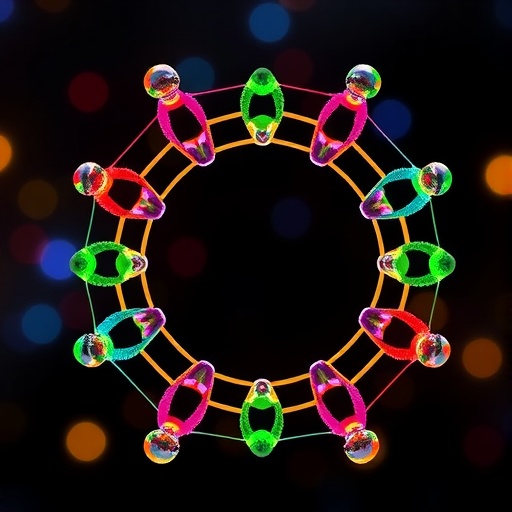In the ever-evolving realm of supramolecular chemistry, the pursuit of intricate, chiral nanostructures has been a cornerstone of innovative materials science. Among these, cyclic topological architectures such as toroids and Möbius strips have captivated scientists due to their unique geometries and potential applications in nanoelectronics, optics, and catalysis. Despite their promise, the fabrication of well-defined chiral toroidal or Möbius strip nanostructures from macrocyclic molecules has been a formidable challenge, often limited by synthetic complexity and instability during assembly. However, a pioneering study recently published in National Science Review unveils an elegant breakthrough in this domain, utilizing chiral amphiphilic pillar[5]arene derivatives to engineer hierarchical, chiral toroidal nanostructures via solvent-mediated self-assembly.
At the core of this advancement lies the clever molecular design strategy where enantiomerically pure glutamide units are covalently tethered onto the macrocyclic framework of pillar[5]arenes. This conjugation endows the molecules with chiral recognition elements while maintaining amphiphilic balance crucial for self-organization in mixed solvent systems. The researchers employed an anti-solvent method, facilitating the induction of ordered assemblies by modulating solvent polarity and composition, thus guiding the formation of distinct supramolecular topologies. These conditions proved instrumental in overcoming the entropic and energetic barriers typically associated with macrocyclic self-assembly, enabling the emergence of chiral topological motifs that have rarely been documented before.
The assembly process in a tetrahydrofuran (THF)/water solvent system demonstrated remarkable sensitivity to water content. Initial low water percentages fostered the generation of stable bilayer vesicles, a conventional nanostructure often encountered in amphiphile chemistry. Strikingly, when the water fraction was increased to approximately 70%, these vesicular aggregates transformed into discrete toroidal formations. The intricate interplay of non-covalent interactions—hydrogen bonding, van der Waals forces, and π-π stacking among the aromatic macrocycles—was key to stabilizing these ring-shaped architectures. This solvent-dependent morphological evolution underscores the exquisite control achievable over nanoscale topology by fine-tuning solvent parameters.
Beyond the mere structural novelty, the toroidal aggregates exhibited profound chiroptical phenomena that amplify their significance. Specifically, these chiral toroids showed intense blue circularly polarized luminescence (CPL), a rare and valuable optical property pertinent to advanced photonic applications such as three-dimensional displays, optical data storage, and enantioselective sensing. Intriguingly, other aggregated forms like vesicles and less defined nanorings failed to produce CPL signals, highlighting the direct correlation between supramolecular topology and chiroptical functionality. These findings reveal that the toroidal shape itself confers unique electronic and geometric arrangements that enable CPL activity.
Additionally, the chiral toroidal structures demonstrated the ability to function as supramolecular templates, extending their influence to achiral fluorescent dyes. When non-chiral blue or red dyes were incorporated within these assemblies, they too exhibited induced CPL emission—an achievement that conventional vesicle-based assemblies could not replicate. This templating effect stems from the toroid’s chiral environment, which imposes asymmetric perturbations on guest molecules, thus transferring chiral information through non-covalent interactions. This opens promising avenues for engineering novel chiral luminescent materials by harnessing host-guest chemistry in carefully designed nanostructures.
At a mechanistic level, the dynamic reconfiguration of intermolecular interactions plays a pivotal role in the transition from vesicles to toroids and Möbius strip-like nanorings. The precise balance among hydrogen bonding networks, π-π aromatic stacking, and hydrophobic effects navigates the assembly pathway, redefining molecular orientations and packing motifs. Such a delicate interplay illustrates how subtle environmental changes modulate energy landscapes of supramolecular systems, steering the assemblies towards topologies of enhanced complexity and functionality. The Möbius strip-like architecture, in particular, introduces an intriguing twist—literally—that challenges conventional conceptions of molecular topology and chiral expression.
This research not only advances the fundamental understanding of topological assemblies but also exemplifies how molecular-scale design can be translated into mesoscale architectures with tunable properties. By bridging molecule-to-nanostructure hierarchies, the study showcases a robust platform for fabricating topologically rich chiral materials that maintain structural integrity and display controllable optical behaviors. Such materials are poised to impact diverse fields, from chiral photonics and enantioselective catalysis to biomimetic systems and sensor technologies.
Moreover, the solvent-mediated assembly method underscores the potential for environmentally responsive nanomaterials. The marked sensitivity to solvent composition offers a facile and reversible means to manipulate nanostructure morphology and function without requiring synthetic alterations. Such responsiveness is highly desirable for developing smart materials capable of adapting their properties in situ, a key feature for dynamic sensing and controlled drug delivery applications.
Detailed atomic force microscopy (AFM) analyses corroborated the formation of these toroidal structures, revealing well-defined ring-like morphologies at the nanoscale. The visualization of Möbius-like nanorings further validated the successful realization of complex topological supramolecular architectures. These images not only provide direct evidence of the targeted structural motifs but also contribute to unraveling the assembly mechanisms by correlating morphological outcomes with experimental parameters.
The luminescent properties of these assemblies were characterized meticulously, highlighting the unique chiroptical features linked with their topology. The exclusive observation of strong blue CPL from toroidal aggregates distinguishes them as valuable candidates for chiral optoelectronic devices. The amplification of luminescence anisotropy through supramolecular chirality enhances the potential for practical applications where polarization control and light-matter interaction specificity are paramount.
This innovative approach sets a precedent for exploiting macrocyclic chemistry beyond traditional host-guest systems, emphasizing the transformative impact of integrating molecular chirality and amphiphilicity in designing topologically sophisticated nanostructures. Future explorations may expand the library of macrocyclic building blocks, tailoring functional groups to modulate interactions and further diversify achievable morphologies, thus pushing the boundaries of supramolecular topology and function.
In conclusion, the work signifies a milestone in the construction of chiral nanostructures with precise topologies and functional properties governed by solvent-mediated self-assembly and molecular engineering. By harnessing the intrinsic chirality of pillar[5]arene derivatives conjugated with glutamide, the researchers have demonstrated a versatile strategy to fabricate toroidal and Möbius strip-like nanostructures exhibiting remarkable chiroptical behaviors. These findings open exciting prospects for the design of advanced chiral materials with applications ranging from photonics to molecular recognition, marking a significant leap forward in supramolecular nanotechnology.
Subject of Research:
Chiral supramolecular assembly and topological nanostructures
Article Title:
Solvent-Mediated Construction of Chiral Toroidal and Möbius Strip-Like Nanostructures from Amphiphilic Pillar[5]arene Derivatives
Web References:
http://dx.doi.org/10.1093/nsr/nwaf280
Image Credits:
Jie Lu




